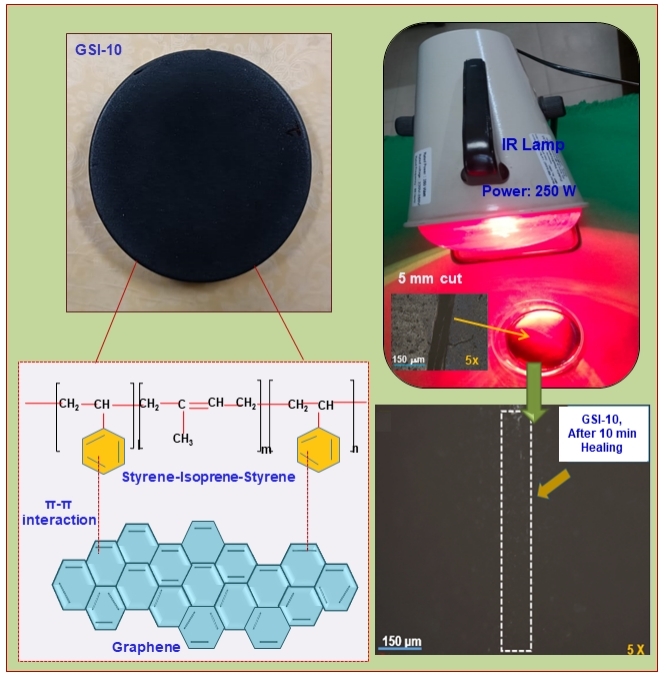 Open Access
Open Access
ARTICLE
Infrared and Microwave Radiation Assisted Self-Healing Property of Exfoliated-Graphene Incorporated Styrene-Isoprene-Styrene Nanocomposites
1 Defence Materials and Stores Research and Development Establishment (DMSRDE), Kanpur, 208013, India
* Corresponding Authors: Shilpi Tiwari. Email: ; Dibyendu S. Bag. Email:
Journal of Polymer Materials 2025, 42(1), 187-204. https://doi.org/10.32604/jpm.2025.057322
Received 14 August 2024; Accepted 20 November 2024; Issue published 27 March 2025
Abstract
Smart materials with self-healing properties are highly desired. This study investigates graphene-incorporated styrene-isoprene-styrene (SIS) nanocomposites for their self-healing property assisted by Infrared (IR) and microwave radiation. The good thermal conductivity and energy-absorbing capacity of graphene offer self-healing capability to SIS/GnP nanocomposites due to their exposure to IR and microwave radiation. The absorbed energy in graphene is transferred to the SIS matrix, facilitating the diffusion, re-entanglement, and restoration of the SIS polymer chains, resulting in multiple times self-healing capabilities using various external stimuli. All SIS/GnP nanocomposite samples exhibit self-healing behavior, and the healing efficiency rises with increasing GnP content in the nanocomposites and healing time. The cut mark on the SIS/GnP nanocomposite sample (having 10 wt.% of GnP) entirely disappears when the sample is placed in contact with IR radiation (at 250 W) for 10 min. In addition, the sample is completely healed when exposed to microwave radiation (at 900 W) for less than 30 s. The good dispersion of the graphene nanoplates in the SIS matrix was observed in SEM micrographs. Strong interfacial interactions between the SIS copolymer chains and exfoliated graphene (GnP) due to π-π stacking stabilize graphene dispersion against agglomeration. The effect of graphene nanoplates on the SIS thermoplastic elastomer’s thermal stability and phase transition is also studied by Thermo-gravimetric analysis (TGA) and Differential Scanning Calorimetry (DSC) analysis.Graphic Abstract

Keywords
Cite This Article
 Copyright © 2025 The Author(s). Published by Tech Science Press.
Copyright © 2025 The Author(s). Published by Tech Science Press.This work is licensed under a Creative Commons Attribution 4.0 International License , which permits unrestricted use, distribution, and reproduction in any medium, provided the original work is properly cited.


 Submit a Paper
Submit a Paper Propose a Special lssue
Propose a Special lssue View Full Text
View Full Text Download PDF
Download PDF Downloads
Downloads
 Citation Tools
Citation Tools
